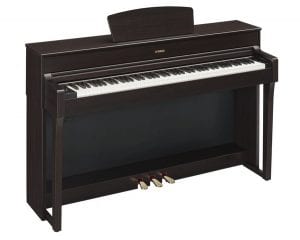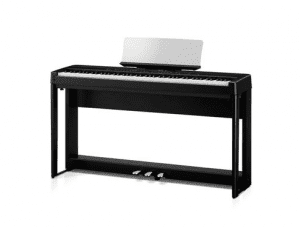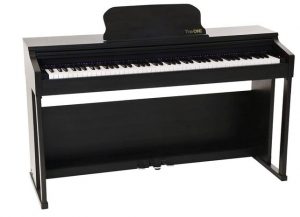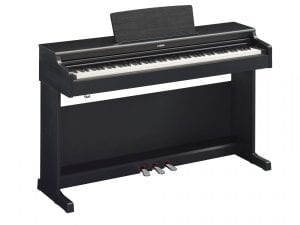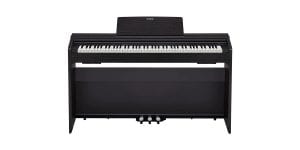The piano is the most revered musical instrument to learn the instrument, but it is not always accessible for practice. Music teachers should have access to pianos to teach music and piano lessons to their students. The type of musical instrument that the piano teacher chooses depends on their class strength and the type of music they teach. Buying an ideal piano is an intimidating task, as there are several options available in the market. Here are some of the best digital pianos for teachers and they come with several features such as built-in lessons, split features, connectivity with smart apps, etc.
What Are the Best Digital Pianos for Teachers?
Purchasing a grand piano as a novice might not be the best choice. In actuality, not everyone ought to get a classical piano. There are several substitutes that may still deliver you a rewarding and enjoyable experience. It just comes down to knowing what will work for you.
- The acoustic piano is a type of stringed percussion where steel strings are struck by soft-coated hammers. The digital piano only performs reproductions of an actual acoustic piano, but it has advantages.
- The acoustic piano differs from such a digital piano in many ways, including look, sounds, features, and cost.
- The system that produces sound on an acoustic and on a digital piano may be the fundamental distinction between both. When you depress the key on an acoustic piano, a felt-covered hammer strikes steel-wired strings, creating that pristine, natural sound we all adore. The digital piano, in contrast, makes use of sensors that are activated by key presses. Headphones or the built-in speakers produce the sound.
- An acoustic piano needs to be tuned and kept in a cool, dry place since humidity affects the tuning. The only real upkeep needed for digital pianos is the periodic cleaning.
- Acoustic pianos are generally more expensive, with entry-level models costing between $1000 and $3,000 on average. This is because of the high-quality wood (maple, for example), steel string, weighted keys, and distinctive design of the instrument.
- The resale value of an acoustic piano can rise over time if it is well maintained, though. Comparatively, a digital piano is substantially less expensive. A low- to mid-range digital piano costs between $200 and $600. The worth of a digital piano will decline with time as technology advances at an exponential rate.
- Acoustic pianos are artistic marvels, but they take up more room. An acoustic piano is substantially bigger and heavier because of the materials used to produce the notes, making it challenging to move.
- You also need to control the surroundings where the piano is located. Keep your instrument, ideally, in a room that stays at a temperature of about 20 degrees Celsius. A digital piano takes up a lot less room and is simple to store. They typically have a collapsible stand, which makes them perfect for moving about and having a small area.
- If you appreciate the sounds of classical music and want to write some of your own, an acoustic piano is your best bet. An acoustic piano is the perfect complement for other traditional instruments because of its tone and sensitive touch.
- Digital pianos are used by musicians to create and contribute to genres including Pop, Rock, and Funk. They use an electronic audio system and a range of sounds to easily adjust to modern instruments.
The finest for long-term investments would be acoustic pianos. It’s not necessary to get a digital piano if you practise on the weekends or in the nights because you won’t be bothering anyone.
Prerequisites Of Pianos For Teachers
Those who want to study the piano receive music instruction from piano teachers. They could be found working in classrooms or as independent contractors that make house calls or operate out of private studios. Piano teachers plan recitals, offer feedback on their students’ development, and help their students get ready for competitions.
A piano instructor may be responsible for the following:
- Before agreeing to a plan, determine the goals and objectives of the students and go over the specifics of the class with them.
- Constructing every class according to the preferences and objectives of the student.
- Supplying suitable materials and resources to the students.
- Attending practice sessions, recitals, tournaments, and other activities on time.
- Teaching music theory and assisting students in improving their methods for memorising, sight-reading, and improvisation.
- Using technology, such as digital pianos, into teaching.
- Lessons should be recorded so that students can analyse their own errors and track their development.
- Educating pupils in preparation for exams, recitals, performances, and other activities.
- Motivating kids, particularly when they are having difficulties and making little progress.
- Giving helpful criticism and modifying teachings as necessary.
On the other hand, it becomes essential for a piano teacher to have these qualities to be good at what they are doing:
- A teaching certificate and a music education bachelor’s degree may be necessary.
- Strong musical talent and a track record of proficiency at the piano.
- It would be beneficial to have prior teaching experience in music.
- Good sight-reading skills.
- Outstanding interpersonal and communication abilities, as well as patience.
- Powerful motivational abilities.
- The capacity to recognise one’s assets and faults.
- The ability to visit students’ families if necessary.
Teachers can stay up to date on the most effective strategies for assisting their students thanks to new research in piano teaching techniques and practice. Great instructors are lifelong learners who attend workshops and conferences, keep up on the most recent techniques, and collaborate with other educators. The best teachers are those who consider themselves to be lifelong learners. They are open to new concepts and have a constant desire to learn. As opposed to simply teaching the same concepts in the same manner every time, this makes it interesting.
Volume And Versatility In Digital Pianos Vs Advanced Pianos.
The volume range of a conventional piano is determined by how hard you push the keys. Predominantly, digital pianos have simple volume controls with a wide range and that the majority of models allow for headphones-only practice. Due to the extensive sound sets built into digital pianos, you may easily add drums and woodwinds, brass, percussion, and many other sounds to your performance.
Also check: Top 14 Best Digital Pianos for Advanced Pianists
Top 5 Best Digital Pianos for Teachers
Digital pianos have come with huge advances in recent years and are made of high-quality sound and diverse features. They are also available at a relatively low cost and are a great alternative for many piano teachers.
#1. Yamaha YDP184 Digital Piano -Best Overall
| Features | Rating |
| Performance and sounds | 9.6 |
| Connectivity | 9.2 |
| Easy to Assemble | 9.4 |
| Build Quality | 9.3 |
| Value for money | 9.5 |
Check Price on Online Stores:
The Arius YDP184 is a flagship piano model that emulates the stunning sounds of the Yamaha CFX concert grand piano. The pianist can also customize the piano sounds in their ‘piano room’ by adjusting diverse parameters such as damper resonance, string resonance, and touch response. The virtual resonance modeling technology of the digital piano simulates similar to the acoustic piano, where one sound of the string causes the sympathetic vibrations in other strings. The soundboard of this piano mediates sympathetic vibration in other strings and the soundboard offers the pianist a full, rich, and very grand piano sound.
This true grand piano is matched with an expressive and authentic keyboard that makes the YDP-184 Arius a flagship Arius digital piano. The piano utilizes a spring-free hammer mechanism similar to what is present in the grand piano. Its GH3 keyboard action helps in reproducing the touch of an acoustic instrument and offers a heavier feel in the lower register to a lighter touch in the upper keys. The piano also features a three-sensor configuration that senses and interprets the behavior of the keyboard, to create a grand piano playing experience.
This is a great piano for teachers and offers sparkling highs and highly powerful resonance bass to project the sounds in a room full of students. In a grand acoustic piano, its sound resonates all through the body of the instrument. The virtual resonance modeling technology in this piano also produces rich reverberation that envelops the students in rich sound.
Pros
- The VRM technology allows bright, vivid, and richly varied expression in this piano.
- Its graded hammer 3 actions 88-key digital keys have synthetic ivory and ebony keytops to reproduce the touch of an acoustic piano.
- The half-damper pedal creates detailed nuances while playing and pedaling on this grand piano.
- The MIDI recording function that is built in this instrument allows players to record performances.
Cons
- This is a heavy piano and is not portable
- The keys are a bit clicky when they bottom out.
Note: This piano is also featured in our lists of Best Upright Pianos for Advanced Pianists and pianos for composing.
#2. Kawai ES920 Portable Digital Piano – Editor’s Pick for Teachers
The ES920 88-key digital piano features a responsive hammer III action keyboard action with exceptional key switches. The piano features improved acoustic piano sounds with upgraded virtual technician parameters. The piano holds an enhanced touch curve setting with ten touches presets. The piano offers tones of other musical instruments such as drawbar, E. Piano, Electric bass, Jazz organ, harpsichord, and string sounds. This Kawai piano is compact, powerful, and amazingly lightweight and thus this piano is perfectly suited for the stage, home, school, and studio.
This is a perfect digital piano for teaching situations as well and the split mode in this piano helps teachers and students to play simultaneously. The sounds of the piano are delivered with the help of its powerful stereo speaker systems. The piano also incorporates the latest audio processing and amplification technology, that was developed in collaboration with the audio specialists at Onkyo. The piano has a wide range of connectivity features, that include Bluetooth MIDI and audio connectivity features.
ES920 delivers outstanding tone and a touch of a concert grand piano, and it is one of the most capable and portable pianos available. It is also compatible with Kawai’s PianoRemote app, which makes listening to music from a tablet or smartphone extremely impressive. The wired connectivity feature of this piano is also supported with the standard USB and MIDI features.
Pros
- The piano has a responsive hammer III keyboard action with authentic sounds produced by Harmonic Imaging XL technology.
- The built-in speakers in this piano are capable of handling a small hall with no need for external amplification, and there is no need for piano tuning as well.
- The action of this piano is so fluid and smooth and mimics the tone of the SK-EK concert grand piano.
Cons
- The piano comes only with a single pedal.
- The piano doesn’t have a modulation wheel.
Note: This piano is also featured in our lists of Best digital pianos under $2000 and best pianos for classical pianists.
#3. The ONE Smart Digital Piano – Best Quality
Check Price on Online Stores:
This is an exceptional upright piano with an 88-keys key bed and is a great instrument for exceptional stage shows and for teachers wishing to offer piano lessons. One best feature of this piano is that it is guided by LED lights to play music with guidance, and is extremely suitable for teaching piano lessons. These lights work with the app and the lights will light, until the pianist hits the right notes, before moving on to the next.
The piano also comes with 4000+ sheet music and hundredths of videos and games in its free apps. The piano also supports iOS and Android tablets and phones and also features MIDI output and recording features. There are several practical features in this piano which include volume controls, a metronome, two 25W built-in amplifiers, and two headphone sockets.
The ONE Smart piano comes with three pedals at the base of the piano, which offers the pianist a complete range of control over the sounds of the instrument. The pedals can also be controlled with its apps to help teachers teach guided piano lessons to the students. The instrument also has 128-note max polyphony for a realistic sounding experience and exceptional playing experience.
Pros
- This is a high-grade piano with 88 weighted keys, professional stereo sound, three-pedal systems, and a classic wooden body.
- This piano has been built for beginners and is loved by teachers and musicians.
- There are two earphone sockets on this piano and we can allow the sound to come from both the earphone and the speakers.
Cons
- The piano keys don’t feature graded hammer action techniques.
- There is no owner’s manual with the purchase.
Note: This piano is also featured in our lists of Best digital pianos for small spaces and best upright pianos for intermediate players.
#4. Yamaha YDP164 – Great Piano For Professionals
| Features | Rating |
| Performance and sounds | 9.6 |
| Connectivity | 9.2 |
| Easy to Assemble | 9.7 |
| Build Quality | 9.4 |
| Value for money | 9.6 |
Check Price on Online Stores:
The GHS weighted action is this piano is heavier at the lower keys and they are lighter at the higher keys, similar to an acoustic piano. The Arius YDP164 is a great choice for students and piano teachers. The piano features an 88-note weighted action with synthetic ivory and ebony keytops for an authentic piano feel and playing experience. The piano connects with the iOS devices with the help of the smart pianist app, and this helps in analyzing the songs stored in the music library, helping piano teachers to learn and play along with their favorite songs.
The state-of-the-art recording method of this piano recreates and samples the sounds of the iconic Yamaha CFX grand piano. The piano also has fashionable and graceful curves and its weighted keys help in reproducing the controlled and responsive touch of the grand acoustic pianos. The virtual resonance modeling technology of the piano emulates the natural feeling of an acoustic piano, even with headphones.
As this piano works with smart devices, the selection of voices and choosing its settings will be much easier than ever. We can access the smart features with the help of a smart pianist app and USB connectivity. The three pedals of this piano help in emulating unlimited expressions and offer the essential control and feel of acoustic pianos.
Pros
- The half-damper pedal controls allow for continuously increasing amounts of sustain as the pedal is depressed.
- The CFX grand piano voices recreate the tone and power of the flagship CFX concert grand piano from Yamaha.
- The keytops have a special matte finish that is designed to absorb moisture and remain tactile with extended use, without getting slippery.
- Its headphone helps to practice duets and help the pianist to work quietly with a piano teacher/student.
Cons
- The piano has only 64-note polyphony.
Note: This piano is also featured in our lists of Best sounding digital pianos and top 15 pianos in the market.
#5. Casio Privia PX-870 Digital Piano – Good Choice for Teachers
Check Price on Online Stores:
The sound technology of this piano helps with unprecedented natural production, rich expressive power, and resonance of a grand acoustic piano, which qualifies it to be an exceptional instrument for piano teachers. The newly developed multi-dimensional AiR sound source of the piano helps in expressing the rich and resonating tones of the piano. This sound system helps in projecting sounds upwards and downwards similar to a grand piano. Its built-in speakers offer a deep listening sensation, similar to a grand piano.
The keyboard of this piano features a tri-sensor scaled hammer action keyboard that detects touches of the keys sequentially. The simulated ivory and ebony keys of this piano offer a luxurious texture and feel for the pianist. The surface of the keys has a detailed crimp finishing that inhibits slipping of a finger due to sweat. Thus, both piano teachers and students can enjoy a perfect fingertip fit, even while playing for long periods.
The volume and quality of the sound from this piano change when the lid on the grand piano is either lowered or raised. The lid simulator recreates the same acoustic effect for enhanced enjoyment on a digital piano. The length of its expressions and reverberations that the piano produces will vary depending on the speed at which the players release their fingers, after touching the keys.
Pros
- The new keyboard system of this piano incorporates a key-off simulator that reproduces these nuances from the key releases naturally.
- The hall simulator function of this piano simulates the acoustic sounds of world-famous concert halls.
- Its advanced equalizing systems assure full enjoyment of vital piano sounds for the piano teachers.
- The piano has installed the audio data recordings of ten live orchestra performances.
Cons
- The cabinet of this piano is not made of solid wood.
- The keys of the piano are slightly noisy.
Note: This piano is also featured in our lists of Best digital pianos under $1500 and best home digital pianos.
Things to consider before choosing a digital piano for teachers
For piano teachers, it is not suitable to fix a low-cost piano with meager built-in tools. As they are taking up piano lessons for students, they have to choose pianos with ample functionalities and built-in tools for teaching music to the students. Here are some things to consider before choosing a digital piano for teachers.
1. Portability and convenience of the piano
Digital pianos are generally lighter and are usually compact than acoustic pianos. Even the console model pianos have a cabinet that resembles a traditional piano and weighs far less than their acoustic counterparts. Choose models that can be broken down easily for storage and for transporting to new places for teaching piano lessons.
2. Volume and versatility
The traditional pianos will generate volume depending on how hard the players strike the keys. Piano teachers should choose models with built-in speakers to allow the piano lessons to reach all the students. Also choose instruments that have built-in sounds of drums, percussions, brass, woodwinds, and other sounds to add to the performance.
3. Teaching and learning tools
The pianos that are meant for piano teachers should have built-in lessons, metronomes, teaching exercises, and chord displays along with access to online resources. Also, choose pianos with dual headphone jacks to allow students and the piano teachers to work silently. Choose pianos with a split-keyboard function to allow both the teacher and the student to play the same octaves.
Final Words
All the pianos that we have discussed here appeal to the skill level and the expertise of the pianist and hold numerous connectivity options and a host of teaching and learning tools for piano teachers.
Frequently Asked Questions (FAQs)
1. What is known as an Arpeggiator?
Arpeggiator: A keyboard feature that, in order to heighten the grandeur of a performance, creates an arpeggio (a simple major chord) whenever a single note is played.
2. What is the function of a Damper pedal?
A pedal known as a damper sustains a note’s persistence until it is released. Likewise known as a sustain pedal. When there are two or three pedals, the damper pedal is the farthest to the right. The damper pedal is typically the sole pedal on a digital piano.
3. Why is patience important in a piano teacher?
It requires discipline and diligence to learn how to play an instrument like the piano. It also takes time! An excellent teacher is patient and lets the pupil set the pace for the learning process.
4. How does the number of sounds/ tones influence one in buying a piano?
Today’s pianos frequently feature hundreds of sound samples from instruments like a, flutes, accordions, organs, synthesisers and more, which may seem like a huge deal at first, but as the novelty wears off, you’ll probably find oneself preferring to the more basic piano sounds. The availability of countless tones and effects might become distracting. Nevertheless, some effects, such as sparingly applied reverb, might improve the sound.


